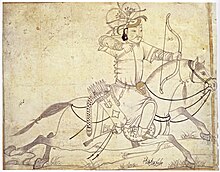Ilkhanate
[12][13] The Ilkhanid rulers, although of non-Iranian origin, tried to advertise their authority by tying themselves to the Iranian past, and they recruited historians to present the Mongols as heirs to the Sasanian Empire (224–651).[14] Native intellectuals interested in their own history interpreted the unification by the Mongols as a revival of their long-lost dynastic tradition, and the concept of "Land of Iran" (Irān-zamin) was considered an important ideology and was further developed by the later Safavid Empire (1501–1736).[15] When Muhammad II of Khwarazm ordered a contingent of merchants, dispatched by the Mongols, to be killed, Genghis Khan declared war on the Anushtegin dynasty in 1219.By 1237 the Mongol Empire had subjugated most of Persia (including modern-day Azerbaijan), Armenia, Georgia (excluding Abbasid Iraq and Ismaili strongholds), as well as all of Afghanistan and Kashmir.Realizing the danger posed by the Mongols, the rulers of Mosul and the Armenian Kingdom of Cilicia submitted to the Great Khan.[22] In accordance with a complaint by the governor Arghun Aqa, Möngke Khan prohibited ortogh-merchants (Mongol-contracted Muslim traders)[23][24] and nobles from abusing relay stations and civilians in 1251.Möngke Khan granted the Kartids authority over Herat, Jam, Pushang (Fushanj), Ghor, Khaysar, Firuz-Kuh, Gharjistan, Farah, Sistan, Kabul, Tirah, and Afghanistan.The Ilkhanid army then crossed the Terek River, capturing an empty Jochid encampment, only to be routed in a surprise attack by Nogai's forces.During his early rule, the Ilkhanate experienced mass revolts by its subjects, with the exception of the Seljukids and Artuqids in Anatolia and Mardin.Stung by the defeat, Abaqa executed the local regent Mu'in-ad-Din Pervane and replaced him with the Mongol prince Qongqortai.To fund his campaigns, Arghun allowed his viziers Buqa and Sa'd-ud-dawla to centralize expenditures, but this was highly unpopular and caused his former supporters to turn against him.His vizir Sadr-ud-Din Zanjani tried to bolster the state finances by adopting paper money from the Yuan dynasty, which remained largely unsuccessful.On the other hand, the China-based Yuan dynasty was an ally of the Ikhanate and also held nominal suzerainty over the latter (the Emperor being also Great Khan) for many decades.[37][38] In terms of foreign relations, the Ilkhanids' conversion to Islam had little to no effect on its hostility towards other Muslim states, and conflict with the Mamluks for control of Syria continued.The Battle of Wadi al-Khaznadar, the only major victory by the Mongols over the Mamluk Sultanate, ended the latter's control over Syria for a few months.For the most part, Ghazan's policies continued under his brother Öljaitü despite suggestions that he might begin to favor Twelver Shi'ism after he came under the influence of the theologians al-Allama al-Hilli and al-Bahrani.[38] Some of the Buddhists who survived Ghazan's assaults made an unsuccessful attempt to bring Öljeitü back into Buddhism, showing they were active in the realm for more than 50 years.Öljeitü's historian Qāshāni records that Kutlushah, after losing patience with a dispute between Hanafi and Shafi'i Sunnis, expressed his view that Islam should be abandoned and Mongols should return to the ways of Genghis Khan.[45] Ghiyas-ud-Din put a descendant of Ariq Böke, Arpa Ke'un, on the throne, triggering a succession of short-lived khans until "Little" Hasan took Azerbaijan in 1338.[67] To reinforce their authority, both Kublai and his successor Temür dispatched their own agents, including Bolad, Qadan, and Baiju, to Iran to oversee and influence over the Ilkhanid politics.[72] The Ilkhanid rulers, who were keen to increase their autonomy, supported their Persian bureaucrats' promotion of the traditional Iranian idea of kingship.The Persian concept of monarchy over a territorial empire, or more specifically, the "Kingship of the Land of Iran" (pādshāhi-ye Irān-zamin), was easily sold to their Mongol masters by these bureaucrats.The Mongols administered Iraq, the Caucasus, and western and southern Iran directly with the exception of Georgia, the Artuqid sultan of Mardin, and Kufa and Luristan.[77] Even prior to the peace treaty's conclusion, the Ilkhan began sending large and richly-equipped pilgrimage (hajj) caravans from Iraq.[78][79] He also arranged for his name to be read aloud in the khutba (Friday sermon) in Medina for a time in 1318 and sent the kiswa (the ceremonial cloth covering the Kaaba) to Mecca in 1319.[79] In 1325, Chupan undertook the pilgrimage and sponsored repairs to the water supply in Mecca and the construction of a madrasa (college) and a hammam (bathhouse) in Medina.[82] The most famous work of this time is the Jami' al-tawarikh ('Compendium of Histories') of Rashid al-Din, initially commissioned by Ghazan but presented to Öljeitü upon its completion in 1307.[82] Ghazan also patronized Abu al-Qasim Qashani, who composed the Ta'rikh-i Uljaytu ('History of Öljeitü'), and Shihab al-Din Waṣṣaf, who wrote the Tajziyat al-amṣar wa-tazjiyat al-a'ṣar ('The Allocation of Cities and Propulsion of Epochs'[83]).[93] Among these examples is the base of the largest preserved candlestick from Islamic-era Iran, commissioned by one of Öljeitü's viziers in 1308–09 and measuring 32.5 centimetres (13 in) high.[102] This accounting system was adopted primarily as the result of socio-economic necessities created by the agricultural and fiscal reforms of Ghazan Khan in 1295–1304.












 ), sailing the
Indian Ocean
towards the coast of India under the control of the
Delhi Sultanate
(
), sailing the
Indian Ocean
towards the coast of India under the control of the
Delhi Sultanate
(
 ), in the
Catalan Atlas
(1375).
[
97
]
), in the
Catalan Atlas
(1375).
[
97
]

PersianGhazanAdministrative regionMongol EmpirekhanateMaraghehTabrizSoltaniyehlingua francaMongolArabicTurkicBuddhismMonarchyHulagu KhanAbu Sa'idAbbasid CaliphateNizari Ismaili stateSultanate of RumKingdom of GeorgiaQutlugh-KhanidsAyyubid dynastySalghuridsAnatolian beyliksJalayiridsChobanidsMuzaffaridsKartidsSarbadarsInjuidsMihrabanidsEretnidsMamluksSutayidsromanizedHülegüGenghis KhanWest AsianCentral AsianMöngke KhanAzerbaijanTurkeyArmeniaGeorgiaAfghanistanTurkmenistanDagestanTajikistanBlack DeathAbu Sa'id Bahadur KhanSasanian EmpireSafavid EmpireYuan dynastyTimeline of the IlkhanateMuhammad II of KhwarazmAnushtegin dynastyThe Mongols overran the empireSubutaiTransoxianaJalal ad-Din MingburnuChormaqanÖgedeiKermanRashid al-DinJami' al-tawarikhHamadaninvaded Armenia and GeorgiaBagratid ArmeniaSeljuksAbbasidIsmailiKashmirBattle of Köse DağAnatoliaSeljuk Sultanate of RûmEmpire of TrebizondGreater KhorasanMughan plainArmenian Kingdom of CiliciaTranscaucasiatumensGüyük KhanArghun Aqaortoghrelay stationsWest AsiaPushangSistanDoquz Khatunhorse archerHulegu KhanNasir al-Din al-TusiChinese calculating tablesdestroyed the Nizari Ismaili stateAyyubid SyriaAleppokuriltaiPalestineBattle of Ain JalutJochidGolden Hordedeclared warBaybarsTerek RiverSilver dirhamMazandaranSeljukidsArtuqidsMardinShams al-Din JuvayniTiflisGhiyas-ud-din BaraqChagatai KhanateTekuderBukharaBattle of ElbistanArghunQara'unasMuslimKublai KhanNawruzQur'anThe Free Man's Companion to the Niceties of PoemsfrontispieceIsfahanGaykhatu

